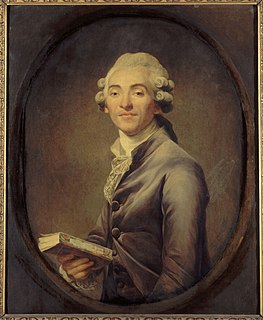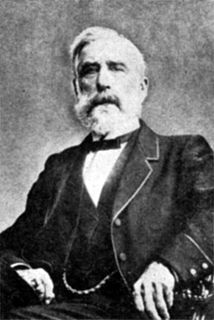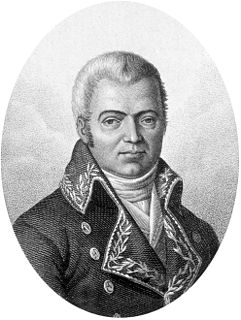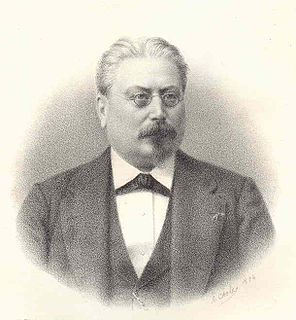
Marie Jean Pierre Flourens, father of Gustave Flourens, was a French physiologist, the founder of experimental brain science and a pioneer in anesthesia.

Michel Eugène Chevreul was a French chemist whose work influenced several areas in science, medicine, and art. His early work with animal fats revolutionized the manufacture of soap and of candles and led to his isolation of the heptadecanoic (margaric), stearic, and oleic fatty acids. In the medical field, he was first to demonstrate that diabetics excrete glucose in the urine and to isolate creatine. He lived to 102 and was a pioneer in the field of gerontology. His theories of color "provided the scientific basis for Impressionist and Neo-Impressionist painting." He is one of the 72 French scientists, mathematicians, and engineers whose names are inscribed on the Eiffel Tower; of those 72, Chevreul was one of only two who were still alive when Gustave Eiffel planted the French Tricolor on the top of the tower on 31 March 1889.

Bernard-Germain-Étienne de La Ville-sur-Illon, comte de Lacépède or La Cépède was a French naturalist and an active freemason. He is known for his contribution to the Comte de Buffon's great work, the Histoire Naturelle.

Abbé Charles-Étienne Brasseur de Bourbourg was a noted French writer, ethnographer, historian, archaeologist, and Catholic priest. He became a specialist in Mesoamerican studies, travelling extensively in the region. His writings, publications, and recovery of historical documents contributed much to knowledge of the region's languages, writing, history and culture, particularly those of the Maya and Aztec civilizations. However, his speculations concerning relationships between the ancient Maya and the lost continent of Atlantis inspired Ignatius L. Donnelly and encouraged the pseudo-science of Mayanism.

Louis Léon César Faidherbe was a French general and colonial administrator. He created the Senegalese Tirailleurs when he was governor of Senegal.

Henri Louis Frédéric de Saussure was a Swiss mineralogist and entomologist specialising in studies of Hymenoptera and Orthoptera. He also was a prolific taxonomist.

Pierre Marie Auguste Broussonet, French naturalist, was born at Montpellier. His father, François Broussonet (1722-1792), was a physician and professor of medicine at famous Université de Montpellier. His brother, Victor, studied there and later became its dean. Henri Fouquet (1727-1806), a professor at the medical school, was a relative, as was Jean-Antoine Chaptal (1756-1832), who subsequently became minister of the interior.
Joseph Honoré Simon Beau was a French physician, who is famous for his investigations of the physiology of the heart and the lungs.

Henri Gougerot was a French dermatologist born in Saint-Ouen-sur-Seine. Gougerot is remembered for his work with numerous dermatological disorders.

Pierre Carle Édouard Potain was a French cardiologist born in Paris.

José Francisco Correia da Serra was a Portuguese Abbot, polymath – philosopher, diplomat, politician and scientist. In some circumstances, he was also known as Abbé Correa. The plant genus Correa, native to Australia, is named in his honour.

The Roman Catholic Diocese of Perpignan–Elne is a diocese of the Latin Rite of the Roman Catholic Church in France. The diocese comprises the Department of Pyrénées-Orientales. This see continues the old Diocese of Elne, which was renamed and had its see relocated at Perpignan, in 1601 after a papal bull of Pope Clement VIII. Its territory brought together the Diocese of Elne, part of the Spanish Diocese of Urgel known as French Cerdagne, three cantons of the Diocese of Alet, and two villages of the Diocese of Narbonne.

Paul Louis Duroziez was a French physician remembered for describing Duroziez's sign and Duroziez's disease. He studied medicine in Paris, graduating in 1853. He worked with Jean-Martin Charcot and later as a surgeon in the Franco-Prussian war in 1870. He worked as a general practitioner rather than in hospital, but was highly regarded by physicians for his publications on heart disease. He was elected president of the Société de Médecine in 1882 and became a Chevalier of the Légion d'honneur in 1895.

Jules René Bourguignat was a French malacologist, a scientist who studied mollusks. He served as secretary-general of the Société malacologique de France. During his lifetime, he traveled widely, visiting, for example, Lake Tanganyika and North Africa. He reportedly defined 112 new genera and around 2540 new species of mollusks.

Charles-Albert-Marie Costa, Marquis de Beauregard was a French historian and politician. He also fought in the Franco-Prussian War. His works include a trilogy on Charles Albert of Sardinia.
Anacharsis Evariste Baizeau was a French military physician.

Guillaume-Isidore Baron de Montbel was a French politician who was a mayor of Toulouse, a deputy and a minister in the French government during the last year of the Bourbon Restoration. He was an ardent royalist and opposed to the freedom of press. After the July Revolution of 1830 he was tried in absentia and sentenced to civil death. He was later pardoned and returned to France.

Mathieu de Dombasle (1777-1843) was a French agronomist. He was one of the first French farmers to grow beetroots to producer sugar, until he went bankrupt. He invented the Dombasle plough, and he established a model farm in Roville-devant-Bayon. He was the author of many books about agriculture.

Pedro Francisco da Costa Alvarenga was a Brazilian-born Portuguese physician. He taught Materia Medica at the Lisbon Medical Surgical School and left several works dealing chiefly with cardiology. He was a founder and main editor of the Gazeta Médica de Lisboa.
Jérôme Salomon is a French infectious diseases physician and high-ranking civil servant. He is the French Directeur général de la Santé since 8 January 2018. He became known in France since the COVID-19 pandemic.

















